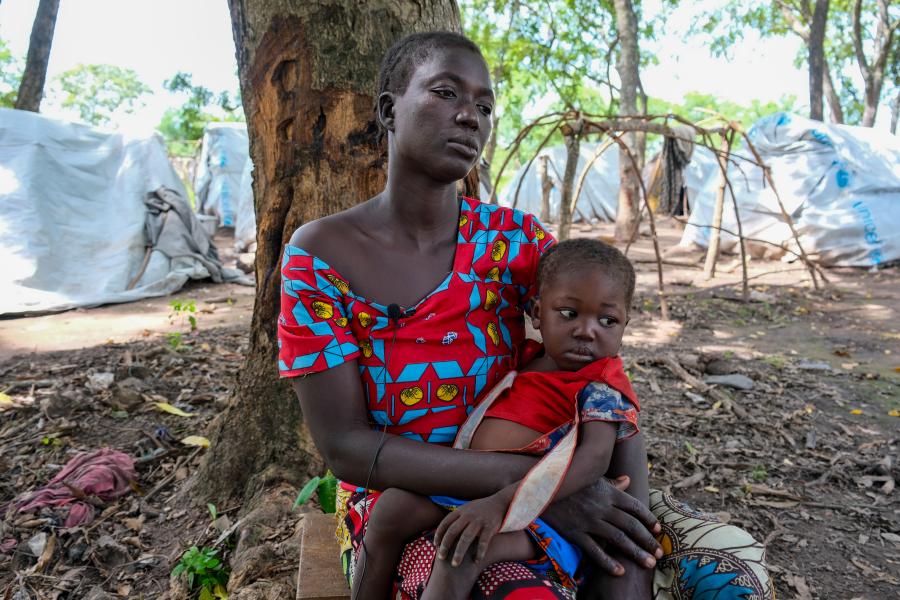The Central African Republic (CAR) faces a complex situation characterized by internal fragility and a volatile security situation in certain areas. Additionally, crises in neighbouring countries lead to refugees crossing into CAR in search of safety and protection, which in turn impacts the country's socio-economic real. More than 1.4 million Central Africans have been displaced from their homes, representing almost a third of the country's total population.
Over 518,000 people are internally displaced, and an estimated 1.1 million Central Africans are at risk of statelessness. Since the outbreak in Sudan in April 2023, CAR has received more than 25,000 refugees and some 6,000 returnees. Over 37,000 Chadian and returnees have arrived at the border with Chad in the last few months. UNHCR works with the Government, NGOs, civil society organizations, and development actors to ensure that the needs of the forcibly displaced are met.
Additionally, UNHCR works to prevent and mitigate statelessness and supports the CAR Government in implementing its national roadmap on the Global Compact for Refugees. In pursuing a longer-term solution for those displaced by the CAR crisis, UNHCR supported the establishment of the CAR Support Solutions Platform, which was officially launched on October 31, 2023.
UNHCR has nine offices across the country, with 132 staff.
Populations
Population types
Note: The "Stateless" category does not include stateless people who are also in other categories, to avoid double counting. The total number of stateless, across all categories, is .
NB: 2025 figures are planning figures.
Source: UNHCR Refugee Data Finder for years until 2022, UNHCR planning figures (COMPASS) otherwise.
Population by country
NB: 2025 figures are planning figures.
Source: UNHCR Refugee Data Finder for years until 2022, UNHCR planning figures (COMPASS) otherwise.
Population by origin
NB: 2025 figures are planning figures.
Source: UNHCR Refugee Data Finder for years until 2022, UNHCR planning figures (COMPASS) otherwise.
Financials
Budget and expenditure trend
Budget information for the current year is updated monthly, while budget and expenditure information for all other years are final.
Budget by pillar
Budget by objective
Note: The table presents the budget for this operation broken down at the objective level. Resource allocation at the objective level is subject to change during the course of the year as the operational situation evolves and priorities shift. The current budget, reflected in the bottom line of this table, is updated on a monthly basis and is replaced by the final budget at year-end.
Expenditure by Outcome Area
Budget by Impact Area
Source: 2023 budget as approved by the Executive Committee in October 2022.
2022 current budget as approved by the High Commissioner as of October 2022; pending presentation to the ExCom's Standing Committee.
Budget by Outcome and Enabling Areas
Source: 2023 budget as approved by the Executive Committee in October 2022.
2022 current budget as approved by the High Commissioner as of October 2022; pending presentation to the ExCom's Standing Committee.
Budget by Impact Area
Source: 2024 budget and 2023 current budget are taken from the budget document approved by UNHCR's Executive Committee in October 2023.
Budget by Impact Area
Budget information for the current year is updated monthly, while budget and expenditure information for all other years are final.
Budget by Outcome and Enabling Areas
Budget by Outcome and Enabling Areas
Budget information for the current year is updated monthly, while budget and expenditure information for all other years are final.
Budget by Impact Area
Budget by Outcome and Enabling Areas
Strategy
Impact Statements
Latest updates
The boundaries and names shown and the designations used on this map do not imply official endorsement or acceptance by the United Nations.
UNHCR GIS data is publicly accessible in the Operational Data Portal






